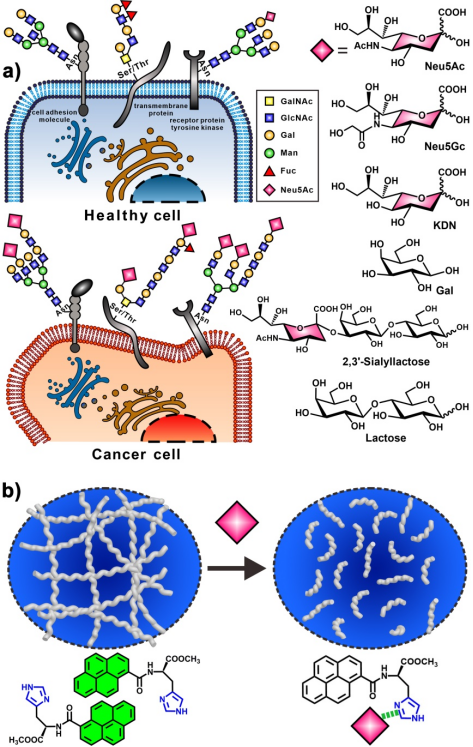Xue Wang, Shengxu Qian, Dongdong Wang, Cunli Wang, Haijuan Qin, Lang Peng, Wenqi Lu, Yahui Zhang and Guangyan Qing*
Journal of Materials Chemistry B 2021, 9, 4960

Sialic acids located at the terminal end of glycans are densely attached to cell surfaces and play crucial and distinctive roles in a variety of physiological and pathological processes, such as neural development, cell-cell interactions, autoimmunity and cancers. However, due to the subtle structural differences of sialic acid species and the complicated composition of glycans, the precise recognition of sialylated glycans is a difficult question. Here, we propose a fluorescent dynamic response system based on a pyrene-conjugated histidine (PyHis) supramolecular gel. Driven by π-π stacking and intermolecular hydrogen bonds, PyHis exhibits strong self-assembly ability and forms stable gels. We find that introduction of N-acetylneuraminic acid (a typical sialic acid) could prevent this self-assembly process, while other monosaccharides or sialic acid analogs have no significant effect on it. Interestingly, a sialylated glycan also has a remarkable inhibitory effect on the gel formation, which highlights the high selectivity of the gel dynamic response system. Mechanism analysis reveals that the sialic acid or sialylated glycan could interact closely with two PyHis molecules stacked together in the assemblies via hydrogen bonding interactions, thereby preventing the ordered accumulation of the gelators. It is worthy noting that the high-efficiency sialic acid recognition effect is not observed at the single-molecule level but at the supramolecular level, indicating the unique superiority of supramolecular self-assembly system in biomolecular recognition and response. This work shows the promising prospects of supramolecular gels in assembly engineering, regenerative medicine, tumor cell sorting and cancer diagnosis.